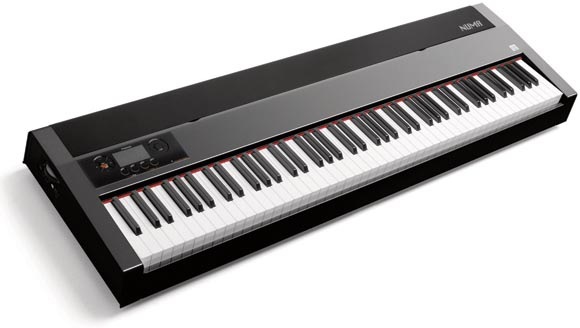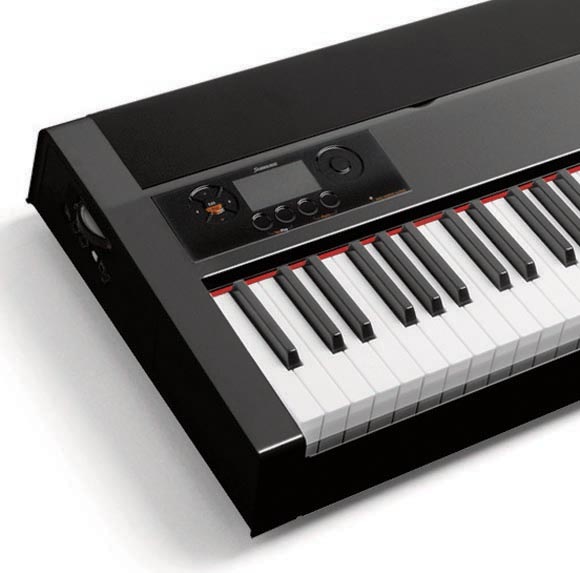There’s a curious distinction in hardware keyboards. You’ll find plenty of keyboards geared for performance with software at the low-end to mid-range. But if you want a keyboard with uncompromising durability and action – and you’re willing to pay more and lift more weight – those choices suddenly disappear. Suddenly, you have to buy a workstation keyboard or something with built-in sounds or even built-in speakers. What if you want a really uncompromising keyboard to use with software and nothing else?
It’s almost as though manufacturers assume “serious” musicians want to gig with built-in sounds on a standalone keyboard. That’s a pretty stunning assumption in the year 2009, given the versatility, reliability, and unmatched sound quality and diversity of software instruments. If you’re looking for a controller alone, your options are limited. M-Audio, Novation, and others have some great affordable options, but nothing really high-end. Roland, Yamaha, and Casio have some nice controllers, but the higher-end models aren’t dedicated to the task, and therefore there’s no way to dedicate all your dollars to the controller itself. (Dig deeper, and there’s still more sacrifices to make – yes, you can have x, but then we take away y…) My short list would probably be Doepfer’s lovely keyboard in a road case and Studiologic – and that’s about it.
Studiologic’s new Numa Nero, therefore, looks like the serious controller a lot of us have been waiting for. It’s a full, 88-note keyboard made for serious musicians. Yes, part of it is plastic, but plastic doesn’t necessarily mean “cheap” – good-quality plastic can be more durable than other materials. And the design itself finally focuses on getting you the best-possible keybed and action, assuming your software will take care of the sound generation.
- Graded hammer action (essential for piano players, as it makes the lower end heavier than the higher end)
- The last key mechanism design by late Fatar founder/designer Lino Ragni
- Double-dipped, “full-body” solid black keys – not hollow black keys. (The press release points out that most digital pianos have hollow keys, which is something I can verify. Unless you play in C major all the time, this is a major problem.)
- 20 dynamic curve settings which “sense” playing in real-time and respond accordingly. It sounds like the piano action equivalent of anti-lock brakes; I have to try it to understand what they mean!
- 4 zones with independent velocity curves, MIDI, program, pedal, and control settings
- Two pedal inputs, plus an illuminated side wheel controller. (The side is an unusual place for a wheel, but I could still see being able to reach it live.)
Now, what’s missing from all of this is a control surface, which bothered me initially – you don’t, for instance, get faders to use as drawbars. Upon reflection, though, I actually think having all that empty space is a huge advantage. If you’re an organ player, you can add a drawbar controller. If you’re controlling unusual instruments, you could add a touchscreen-equipped laptop. Or add a monome. You get the idea.
And the best feature of all may be this: “An aluminum back piece slides out to support another keyboard, sound module, or laptop, without the need for another stand.”
No, my only remaining gripe is that, while the keyboard supports aftertouch, it’s monophonic aftertouch, not polyphonic. Poly aftertouch seems to be a dying breed, but it would certainly have qualified this keyboard as “ultimate.” I’m nonetheless dying to play the Numa Nero. I’ve been waiting a long time for a worthy controller that doesn’t try to make sounds or arrange beats for you or do anything other than talk to your software setup, and this could be it.
US$1274, which goes to prove my point – focus entirely on the controller, and you can keep the cost low without compromise. Weight: 57.3 ponds.
There’s also a 22-pound Numa Nano coming at winter NAMM; keep your eyes out for that one – if it could be just as brilliantly-designed but more liftable, it could be the perfect companion, a nano on the road and a Nero back in the studio (or when you’ve got transport).
And yes, it’s worth considering the entire Studiologic range. Ironically, the line they call “vintage” is the one with lots of added controls. They’re absurdly cheap for the quality, have action that can beat most of the pricier options out there, and immensely logical designs that pack maximum playability into the weight and form factor. The designs are, charitably, “workmanlike,” but if it’s more playable, who cares? I also understand they’re easy to service. Now, the only remaining question is why the Italian-based Studiologic seems to be so alone in getting this area right.

